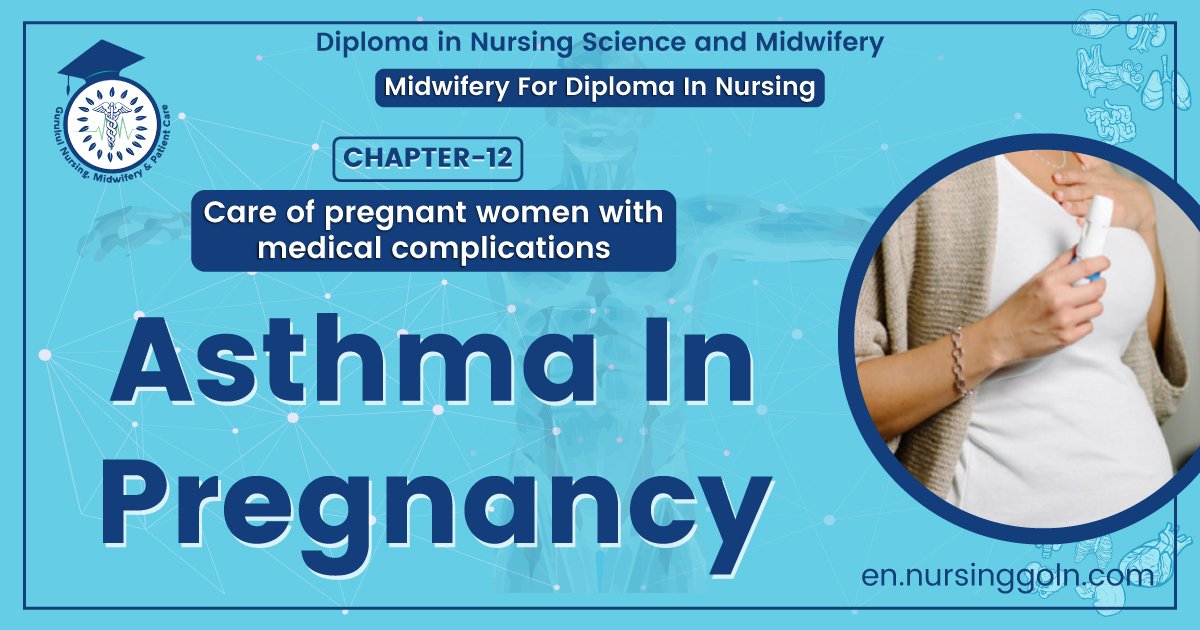Asthma In Pregnancy – This course is designed to understand the care of pregnant women and newborn: antenatal, intra-natal and postnatal; breast feeding, family planning, newborn care and ethical issues, The aim of the course is to acquire knowledge and develop competencies regarding midwifery, complicated labour and newborn care including family planning.

Asthma In Pregnancy
Asthma In Pregnancy
Brief description on asthma during pregnancy
Asthma is a disorder in which paroxysmal dyspnea occurs due to the spasmodic contraction of hyper-reactive air passages, mucus hypersecretion and mucosal edema.
Incidence:
The general prevalence of asthma appears to be increasing. Incidence is about 1-4% of all pregnant women.
Effect of Pregnancy in Asthma:
- Recent information suggests that during pregnancy up to 70% of patients with asthma
- shows improvement, approximately 20% shows no change and up to 10% experience worsening of symptoms.
- In adolescents asthmatic, who become pregnant have a higher percentage of exacerbations.
- Noncompliance of treatment and respiratory tract infections are factors associated with asthma flares.
Complication/Effect of Asthma on Pregnancy:
There is conflicting evidence. In well controlled and actively managed asthmatics perinatal mortality is not affected. But there may be increased risk of
Fetal complication:
- Preterm labor,
- PROM.
- pre-eclampsia,
- IUGR and
- Neonatal hypoxia.
Maternal complications can be
- hyperemesis,
- pneumonia,
- pre-eclampsia,
- vaginal bleeding,
- More complicated labor and more cesarean deliveries.
Women with severe asthma are at the higher risk. However, mothers also are at little or no increased risk when the disease is effectively treated and controlled.
Classification of Asthma:
Classification of asthma is according to severity:
1. Mild intermittent.
2. Mild persistent.
3. Moderately persistent.
4. Severe persistent.
Diagnosis:
Diagnosis is based mainly on clinical grounds.
Symptoms
Symptoms are cough, dyspnea, chest tightness and wheezing.
Investigation:
Pulmonary function studies should be part of initial investigation.
1. Sequential measurement of the forced expiratory volume in one second (FEVI) from
maximum expiration is the single best measure to reflect severity of disease.
2. A FEVI less than 1 liter or less than 20% of predicted value correlates well with severe. disease as manifested by hypoxia, poor response to therapy and a high relapse rate.
3. The peak expiratory flow rate (PEFR) correlates well with FEVI and it can be measured reliably with inexpenshv portable peak flow meters.
Management:
Most patients with asthma can be managed effectively during pregnancy, and complications are generally confined to the patients with uncontrolled asthma. In most cases the disease is well controlled with inhaled P2 agonist like salbutamol, terbutaline, fenoterol, which relieves and corticosteroid like Betamethasone, which prevents.

Mild Intermittent Asthma:
1. These patients do not need daily medication. When symptoms occur 2-4 puffs of a short acting inhaled P2 agonist like salbutamol, terbutaline, fenoterol can be used as needed.
Mild Persistent Asthma:
1. The preferred therapy for this group of patients is a low dose inhaled corticosteroids. Beclomethasone or Budesonide inhalations are administered every 3-4 hours. Inhaled corticosteroids suppress and may even prevent airway inflammation.
2. Cromolyn sodium; It is anti-inflammatory drug but its efficacy is less predictable than inhaled corticosteroids.
Moderate Persistent Asthma:
1. The preferred treatment is a combination of low dose or medium dose inhaled corticosteroids and a long acting P2agonist.
Severe Persistent Asthma:
1. The preferred treatment is a high dose inhaled corticosteroids and a long acting inhaled agonist as well as a systemic corticosteroids such as 2 mg/kg/day of Prednisolone or equivalent steroid not to exceed 60 mg/ day with an attempt to reduce the minimal effective dose. An alternative but not preferred treatment includes a high dose inhaled corticosteroids and sustained release theophylline.
Treatment of Acute Asthmatic Attacks:
Treatment of acute asthma during pregnancy is similar to that for the nonpregnant asthmatic. An exception is significantly lowered threshold for hospitalization of thepregnant women. Status asthmaticus is a severe asthma exacerbation in which oxygenation is difficult despite therapy.
Therapy is:
- Humidified oxygen 30-40%.
- Nebulised beta agonist.
- Subcutaneous catecholamine-epinephrine or terbutaline.
- Intravenous steroid are used if the patient doesn’t respond to subcutaneous catecholamine.
During treatment, fetal monitoring should be used if patients are more than 24 weeks pregnancy. Assessment of maternal oxygenation is also done to guide effectiveness of therapy. If the patient does not respond with these measures and it is difficult to maintain adequate oxygenation, intubation becomes necessary.

Management of asthma during Labor and Delivery:
❖ Regularly scheduled asthma medications are continued throughout labor and delivery.
❖ Low dose corticosteroids are administered to any women receiving systemic steroid
therapy within the preceding 4 weeks.
❖ The usual drug therapy is 100 mg of hydrocortisone given intravenously every 8 hours.
❖ PEFR should be determined on admission. If asthma symptoms develop then serial measurement are made after treatment.
❖ For labor analgesia, a nonhistamine releasing narcotic such as fentanyl may be preferred to meperidine or morphine
❖ Epidural analgesia for labor is ideal.
❖ For surgical delivery, conduction analgesia is preferred because tracheal intubation can trigger severe bronchosfjasm. Syntocinon is better than ergometrine because of bronchoconstrictor effect of ergometrine.
❖ PGF2 should not be used as it precipitates bronchospasm. PGEI and PGE2 compound can be used locally for induction of labor.
❖ Aspirin and nonsteroidal anti-inflammatory drugs like Indomethacin may trigger severe bronchospasm as well as ocular, nasal, dermal and gastrointestinal inflammation in 3- 8% of asthmatic patients and are best avoided.
❖ Inhaled P2 agonist cromolyn sodium, steroids are safe while breastfeeding.
Read More.
